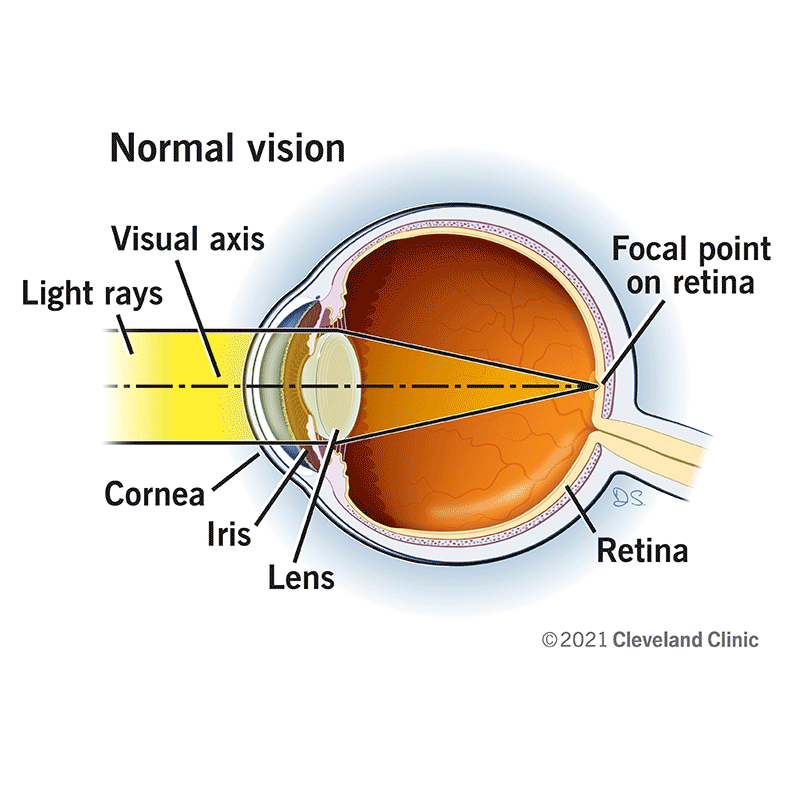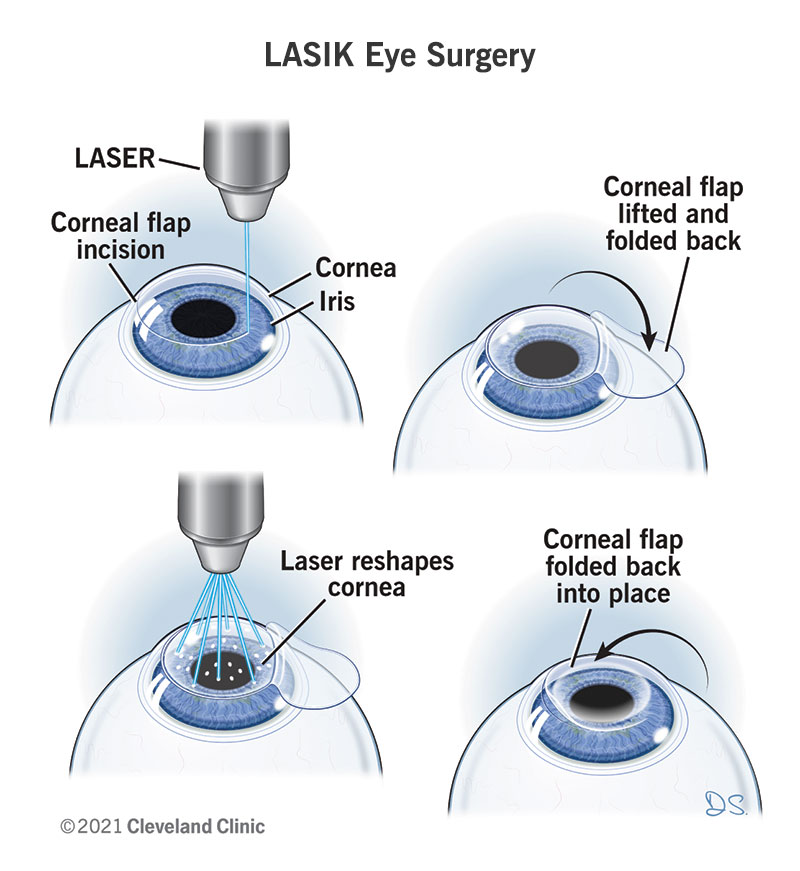LASIK is a laser eye surgery that corrects vision problems. It changes the shape of your cornea to improve how light hits your retina. This improves your vision. About 99% of people have uncorrected vision that’s 20/40 or better after their LASIK surgery. More than 90% end up with 20/20 vision. Dry eye is the most common side effect.

LASIK eye surgery is a refractive eye surgery that uses lasers to fix problems with your vision. This surgery is an outpatient procedure, meaning that you can go home the same day. LASIK corrects refractive errors, which happen when your eye can’t refract (bend) light as it should. Refractive errors lead to blurry vision. LASIK can help you see more clearly and enjoy a better quality of life.
LASIK may be a treatment option for people who don’t want to rely on glasses or contacts to improve their vision. After LASIK, you may not need your glasses or contacts at all. Or, you may need them only in certain situations, like when driving at night or reading. If you’re considering LASIK, it’s important to learn how it works and its benefits and drawbacks so you can make an informed decision. For example, not everyone is a candidate for LASIK. Also, LASIK is typically not covered by insurance.
LASIK changes the shape of your cornea to improve how light hits your retina. This, in turn, allows you to see more clearly. The name LASIK stands for “laser-assisted in situ keratomileusis.” The term “in situ” means “in position” or “in place.” The word “keratomileusis” is the medical term for reshaping your cornea.
Your cornea is the outermost layer of your eye. It’s dome-shaped and made of clear tissue. It works together with another part of your eye called your lens to bend light before it hits your retina. Your retina lines the back of your eye. When light hits your retina, your retina sends electrical signals to your brain that tell you what you’re seeing.
To see an object clearly, you need all the parts of your eye to work together. Think of an assembly line, with your cornea as the person responsible for the first step in making a product. If that person makes a mistake, it throws off the entire process and affects the outcome.
Similarly, when light enters your eye, it goes through your cornea first. Problems with the shape of your cornea prevent light from taking the correct path to your retina.
So, by reshaping your cornea, LASIK allows light to enter your cornea how it should and take the proper path to your retina.
LASIK treats the following conditions:
LASIK permanently changes the shape of your cornea. This improves your eyesight so it’s normal or near normal. However, because your eyes naturally change as you get older, your vision can change in the years following LASIK. This is a normal part of the aging process. Presbyopia usually starts around age 40. At some point, you’ll likely need reading glasses to help you with close-up vision.
Cleveland Clinic is a non-profit academic medical center. Advertising on our site helps support our mission. We do not endorse non-Cleveland Clinic products or services. Policy

Your ophthalmologist or optometrist can tell you how to prepare. In general, you should stop using lotion, makeup and perfume the day before your surgery. These products can get into your eyes and raise your risk of infection. Also, ask someone to drive you to and from your surgery.
During LASIK, a refractive surgeon will:
You’ll be awake, but you won’t feel pain. You may receive a mild sedative to help you relax.
LASIK usually takes 30 minutes or less. During this time, you can expect to look at a light for less than 30 total seconds.
After the procedure is finished, your vision will be relatively clear. People describe their vision as being similar to looking through a dirty window. Your glasses or contact lenses will no longer help you see well after the procedure is completed.
LASIK is an outpatient procedure, so you can go home afterward (but someone else will need to drive you). Your surgeon will give you:
Most people have 90% of their best vision possible after the procedure. Most are able to drive in safely for their post-operative visit, which is typically the next day.
For the first week after your surgery, you may have:
You might be tempted to rub your eyes because they’ll burn or feel itchy. This irritation is normal. It’s essential you avoid touching your eyes at all during the first week so they can heal.
LASIK may give you crisp, clear vision without relying on glasses and contacts. About 96% of people who have LASIK are happy with the results. Those who are unhappy may have hoped for perfect vision and zero reliance on glasses, which isn’t always possible. It’s important to talk to an ophthalmologist about the level of vision correction that’s possible for you.
About 99% of people have vision that’s 20/40 or better (without glasses) after their LASIK surgery. This is good enough to pass the eye exam for a driver’s license. More than 90% end up with 20/20 vision (without glasses).
It’s common to have some side effects from LASIK. These aren’t the same as complications. Side effects usually aren’t serious and go away on their own.
Dry eye is the most common side effect. It affects about 30% of people who have LASIK. The discomfort is most bothersome about three months after your surgery, but it usually goes away after six to 12 months.
Other possible side effects include:
Most side effects occur within the first three months. By six months after your surgery, your side effects should mostly be gone.
Complications are more serious than side effects and may require treatment. More than 99% of people experience no complications. However, it’s important to be aware of the possible complications, including:
LASIK surgery itself hasn’t caused any cases of blindness in people who are appropriate surgical candidates. However, rarely, an untreated infection can lead to vision loss.
Clinical trials and research studies have proven that LASIK eye surgery is safe. Over 9,000 people participated in clinical trials in the U.S. from 1993 to 2005. Plus, over 7,000 research studies have confirmed LASIK is a safe surgery. New technology continues to lower the risk of complications (which is already below 1%).
All surgeries come with some risks. That’s why it’s important to talk to an ophthalmologist or optometrist to learn more about LASIK and whether the benefits outweigh the risks for you. For example, LASIK may not be an option if you have medical conditions like damaged corneas or chronic medical conditions that affect healing. It may be upsetting to learn you can’t have a surgery you want, but eye doctors put your safety first.
Recovery from LASIK is quick. Many people can return to work or drive within a few days. However, use caution before getting behind the wheel. Blurred vision is a common side effect of LASIK, so you shouldn’t drive until your vision has cleared.
You should limit some activities as your eyes heal. Follow your ophthalmologist’s advice based on your specific situation. Some general guidelines include:
You’ll return to your ophthalmologist or optometrist 24 to 48 hours after your surgery so they can test your vision and make sure your eyes are healing. Your provider will tell you how often you should come in for follow-up appointments after that.
Call your ophthalmologist or optometrist immediately if you experience:
Questions you may want to ask include:
The first step is learning whether you’re a candidate. To have this surgery, you must:
You need a comprehensive eye exam to see if you meet these criteria. At your exam, your refractive surgery team will:
To get the most accurate results from your exam, you must stop wearing contact lenses for several weeks beforehand. Contacts change the shape of your cornea and can lead to inaccurate cornea measurements. Your ophthalmologist or optometrist will tell you how long you should go without wearing them.
If you’re a candidate for LASIK, it’s time to learn more about what you’ll gain from the surgery. You can then make a final decision. Your provider will discuss expected outcomes based on your eyes and current vision. Don’t feel rushed or pressured. Take your time and make sure you’re comfortable with all aspects of the surgery.
About 1 in 5 people who want LASIK have medical or eye conditions that prevent them from receiving LASIK. Those conditions may include:
Each type of refractive laser eye surgery has its own benefits and drawbacks. One type isn’t universally best for everyone. The best type of surgery for you depends on many factors, including:
Several types of laser surgery don’t create a corneal flap that goes back to its original position after the surgery (as LASIK does). So, these surgeries might be better for you if you’re not a candidate for LASIK (for example, if your corneas are too thin or your job puts you at risk of eye trauma). Laser surgery alternatives to LASIK include:
Talk to an eye care provider about these options and which is best for you.
A LASIK enhancement is a touch-up procedure that’s done after your initial surgery. It may happen about three months after your surgery or several years later.
An enhancement a few months after your surgery helps you get closer to your vision goal if your initial surgery didn’t correct your vision as much as you’d hoped. This doesn’t mean something went wrong with the surgery. It means everyone’s eyes respond differently, so you can’t always predict how much your vision will improve. An enhancement surgery makes a small change to help refine your vision.
An enhancement can also happen years later due to changes in your vision over time. Again, this doesn’t mean LASIK didn’t work. It means your eyes get older and change just like other parts of your body. As you age, your vision naturally changes. A LASIK enhancement can help correct vision changes that occur after your initial surgery.
A note from Cleveland Clinic
LASIK can give you a whole new view of the world around you. It can improve your vision and reduce your reliance on glasses and contacts for many years to come. But not everyone is able to have LASIK. LASIK is an elective procedure that insurance may not cover. If you’re interested in LASIK, talk to your eye care provider. Together, you and your provider can discuss LASIK and determine if it’s the right fit for you.
Last reviewed by a Cleveland Clinic medical professional on 02/17/2023.
Learn more about our editorial process.
Cleveland Clinic is a non-profit academic medical center. Advertising on our site helps support our mission. We do not endorse non-Cleveland Clinic products or services. Policy